 Do you know if your social media strategy is working?
Do you know if your social media strategy is working?
Are you looking for an easier way to track your social activities?
In this article I'll show you how to find the most valuable social data and actionable insights.
The result, improve your social media strategy on Facebook, Twitter and Pinterest.
Finding the Needles in the Haystack
As marketers, we're on a mission to track and measure our efforts and their success.
We collect information on almost everything you can think of, from purchase history and demographics to psychographic data and everything in between.
The abundance of data has opened up a complicated web of options.
It's important to know how to find the useful data that helps us make strategic decisions.
The following three tips will help you focus on what matters.
#1: Review the Posts Tab on Facebook Insights
Facebook has given marketers access to a ton of useful information with their Page Insights. Most people use this data to measure their success. We're going to look at how to use it to refine your strategy.
Timing Your Posts
Start by going to your Facebook page and clicking on See Insights in the navigation bar at the top of the admin panel.
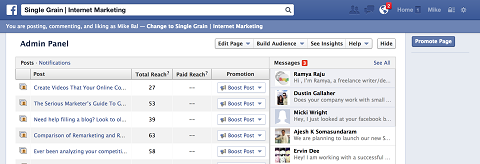
This takes you to the Overview page by default. Click on the Posts option in the Insights navigation bar. This will open up the When Your Fans Are Online insights.
Get World-Class Marketing Training — All Year Long!
Are you facing doubt, uncertainty, or overwhelm? The Social Media Marketing Society can help.
Each month, you’ll receive training from trusted marketing experts, covering everything from AI to organic social marketing. When you join, you’ll also get immediate access to:
- A library of 100+ marketing trainings
- A community of like-minded marketers
- Monthly online community meetups
- Relevant news and trends updates
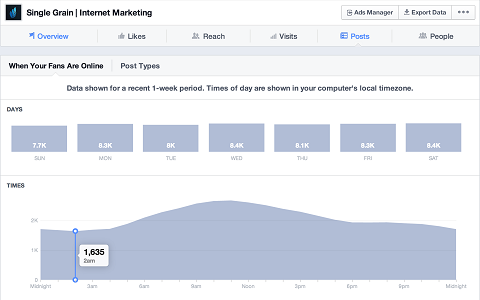
This information is updated weekly and is great to use for adjusting your publishing schedule. Make sure you're posting within 30 minutes of your users' peak activity times. I recommend you test slightly prior to those times so that the post already has some engagement before the majority of your fans are online.
The next step is something a lot of people miss. Look at the vertical bars over each day of the week.

Every audience has different habits. Sometimes one day of the week offers a 50-100% larger audience. These are opportunities you don't want to overlook.
If you have days that stand out, plan on publishing important posts around them.
Next, check for the most active times for each day. The Post Insights page shows you the current day by default. Compare it to other days of the week by scrolling over them to see a line comparison of user activity.
There may be no big difference in activity times, but it always pays to check. I've had extremely successful posts come from opportunities I discovered by checking this data.
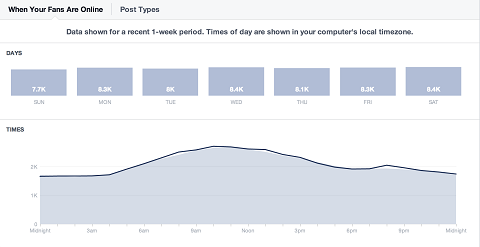
Now that you've got the timing down, let's move on to your post formats.
Tracking Format Preferences
Over the past few years, there's been a shift toward more visual content. Facebook fans were ignoring most link posts and going right for image or video posts, so many social media managers responded by focusing more on entertaining visual content to keep engagement up.
To combat the high amount of low-value visual content being published and push more valuable news feed content, Facebook now previews larger images for link posts. This has helped boost engagement for link posts while making it easier for managers to drive more traffic from the network to their websites and blogs.
While the new format levels the playing field for all post types, it's extremely important to base your strategy on what your fans prefer.
In the Posts section of your Insights dashboard, next to When Your Fans Are Online, click on Post Types.
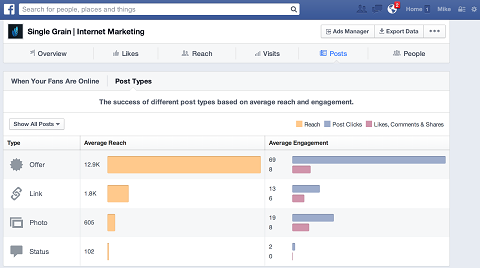
You'll see a simple bar graph that shows you the average engagement for the different post types you've published on your page.
Just because one post type receives the highest amount of engagement doesn't mean it's the only post type you should be publishing. You should constantly test new tactics.
If you want to switch up your publishing style, test different post types and use this information to set a temporary post type mix.
This first section is pretty straightforward, but when you scroll down you see a chart of all of your recent page posts. Something a lot of people miss is the ability to sort all of these posts by the different metrics.
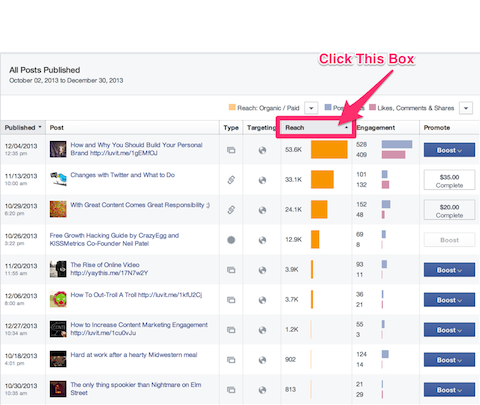
Depending on how social media works in your overall digital marketing strategy, you will want to look at different information; post reach versus post engagement, for example.
Sort your posts to reveal connections you may have missed. By going through your top-performing posts in the page's entire history (relative to your strategy and KPIs), you can start to identify some qualitative factors you might not have thought about before.
Here's a list of what to look for:
- Post content. Is there a visual or contextual theme that has consistently performed well over time? Maybe your fans have a soft spot for Star Wars references.
- Post copy. Are there sentence structures that consistently outperform others? Copy length, personality nuances and literary devices can be a factor.
- Visual themes. Is there something consistent in the imagery you've been using? Bright colors, 3D styling or photography might outperform illustration.
Use the information you gather from the Posts tab to serve up the content your fans want when they're most likely to see it.

Discover Proven Marketing Strategies and Tips
Want to go even deeper with your marketing? Check out the Social Media Marketing Podcast! Publishing weekly since 2012, the Social Media Marketing Podcast helps you navigate the constantly changing marketing jungle, with expert interviews from marketing pros.
But don’t let the name fool you. This show is about a lot more than just social media marketing. With over 600 episodes and millions of downloads each year, this show has been a trusted source for marketers for well over a decade.
Use these tips to refine your Facebook strategy.
#2: Use Twitter Tools to Expand Reach
Although Twitter doesn't directly offer insights, there are a couple of third-party tools I recommend checking out for different reasons.
Finding Influencers With TweetReach
While the breakdown TweetReach gives you for the estimated reach, exposure and impressions of your last 50 tweets is great for reporting, it's nothing to act on strategically. The most valuable information here is the Contributors section.
The Contributors section shows you all of the users who contributed most to your reach during the last 50-tweet period.
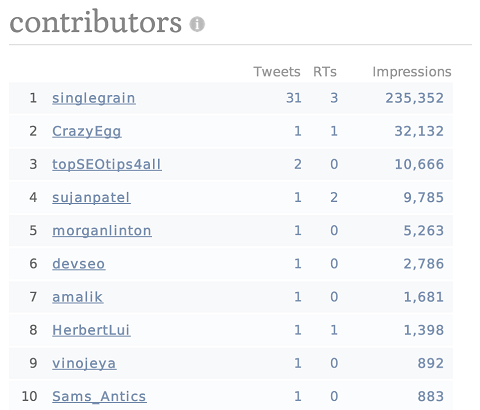
Add these users to a Twitter list and monitor that list using a dashboard like TweetDeck. This helps remind you to reengage them on a regular basis. As this list grows and you increase your engagement with these users, you'll see your engagement, reach and influence grow exponentially.
Ranking Engaging Tweets With Buffer
The new business accounts from Buffer let you sort your tweets/posts by the amount of engagement they receive (much like the Facebook Posts Insights above).
This gives you the same opportunity to scan through your top-performing tweets and break down all of the commonalities you may have missed.
I recommend going through at least your 50 top tweets to look for these things:
- Tweet content. Are links, videos or images more popular?
- Tweet structure. Where's the link placed? Did you use hashtags?
- Tweet copy. What literary devices, personality nuances, etc., did you use?
- Twitter elements. How do you use mentions and hashtags?
Once you find some common themes, test their validity by sending out new tweets using the successful elements you discovered. Be sure to test one variable at a time to limit the assumptions you're making.
Revealing Follower Activity With Followerwonk
The next tool I've recently grown fond of is Followerwonk. Use their Analyze Followers feature to discover the best times to send out your tweets.
Enter your Twitter username, and in the drop-down menu, be sure to change the option from Analyze Users They Follow to Analyze Their Followers. In just a few seconds, you see an hourly breakdown of your followers' activity.
Note: As an added bonus, it's easy to sync Followerwonk's data with your Buffer schedule. Just click the orange button.
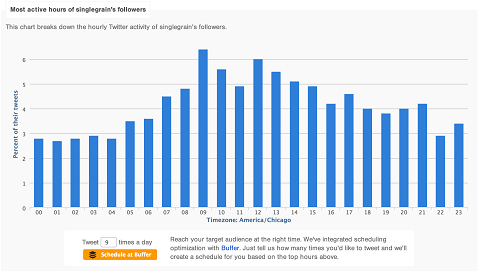
Use these three Twitter tools to build strategic relationships with influencers, optimize your updates and tweet according to when your followers are online, all of which will extend your overall reach.
#3: Optimize Your Pinterest Activity
Not that long ago, Pinterest rolled out a native analytics platform that focuses on the relationship between your website and Pinterest. While the data is useful and worth monitoring, it doesn't really offer insights that can impact your strategy on the network itself.
PinReach, which was recently purchased by Tailwind, has a free version that offers a lot of value when it comes to delivering useful data.
Analyzing Pin Engagement
Use the Pin Inspector feature to review your last 50 pins. Go through the same process you did with Facebook and Twitter to find the top-performing pins and uncover any consistent themes or styles you can identify in them.
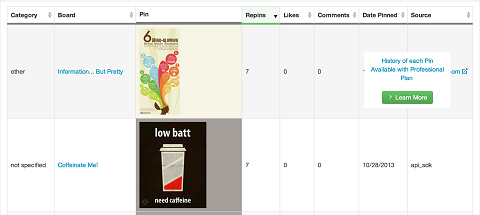
Tracking Category Engagement
The Category Heatmap section shows a viral heatmap and an engagement heatmap. Both of these charts provide a strong visual breakdown of where you're pinning versus where you receive the most engagement. Use this information to help you decide which categories you should focus your attention on and which aren't worth your time.
Whatever you do, don't pin content to those categories that aren't producing relevant results. Instead, get creative with the content you're producing and tie it to a category or theme that's doing well. As always, test everything before making it a regular part of your strategy.
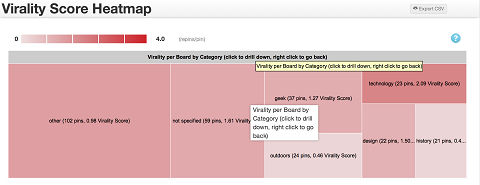
Over to You
Data measurement is a broad subject and I didn't delve into insights for all of the social networks you may be using.
To get better at Instagram, check out Nitrogr.am. Here's what you need to know about insights for LinkedIn company pages. For Google+, read this article.
Meanwhile, use the tools and tips from this article to help you refine your strategic approach to Facebook, Twitter and Pinterest.
What do you think? Where do you find useful data to help you improve your social media marketing? If you have anything you'd like to add or any recommendations for other platforms, please leave them in the comments.
Attention Agency Owners, Brand Marketers, and Consultants

Introducing the Marketing Agency Show–our newest podcast designed to explore the struggles of agency marketers.
Join show host and agency owner, Brooke Sellas, as she interviews agency marketers and digs deep into their biggest challenges. Explore topics like navigating rough economic times, leveraging AI, service diversification, client acquisition, and much more.
Just pull up your favorite podcast app, search for Marketing Agency Show and start listening. Or click the button below for more information.

